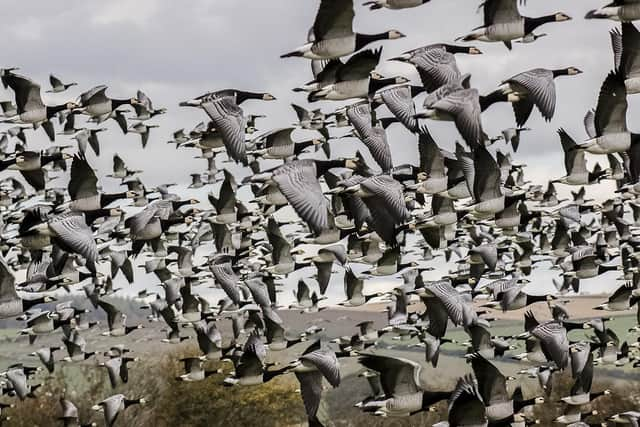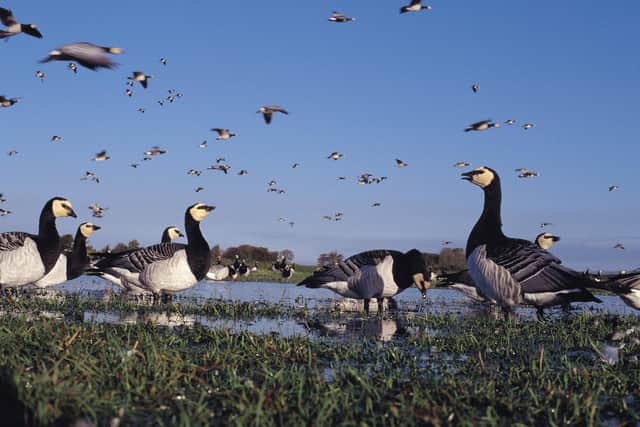Mesmerising sight as Arctic flocks descend on southern Scotland for winter – and Wild Goose Festival
Huge flocks of the birds have been touching down at various sites across the country, with massive numbers of pink-footed geese already spotted at Montrose Basin on the east coast.
In the south-west, barnacle geese are appearing in Dumfries and Galloway after a 2,000-mile flight from their breeding grounds in the Arctic Circle.
Advertisement
Hide AdAdvertisement
Hide AdThese geese, more than 30,000 of them, come to the salt marshes of the Solway Firth each year from Svalbard, an archipelago midway between Norway and the North Pole.
It’s a mesmerising sight – and noisy – offering a special treat for nature-lovers.
Anyone who would like to see the spectacle for themselves and find out more about the Svalbard visitors and other wildlife in the region can take part in a special 10-day celebration being hosted by the Wildfowl and Wetland Trust (WWT).
The Wild Goose Festival, which gets under way on October 19, is offering a packed programme of nature-themed events at various locations.


Highlights include two Dawn Flight specials, taking place at the WWT’s Caerlaverock nature reserve on October 22 and 28, when the visitor centre opens early to give people the chance to witness thousands of geese filling the skies and making a daily pilgrimage to feed on the area’s plentiful grazing fields.
“The Dawn Flight events are an amazing opportunity to see one of nature’s most amazing sights,” said Anna Barlow, visitor experience officer at WWT Caerlaverock.
“It’s hard to explain just how magical it is to see and hear thousands of birds above you and watch them coming down into the reserve after spending the night on the Solway mudflats.
“It’s definitely something you need to experience to really appreciate its beauty.”
Advertisement
Hide AdAdvertisement
Hide Ad

Barnacle goose numbers were below 4,000 when the Caerlaverock site launched in 1971.
Now, after decades of conservation work, up to 34,000 birds – the entire Svalbard population – have been known to flock to the reserve.
David Pickett, WWT’s site manager, said: “A dawn goose roost walk in an ideal way to celebrate with the WWT the huge conservation success of the recovery of the Svalbard barnacle goose population.
“An early morning on the edge of the wild saltmarsh, a spectacle of thousands of birds, sunrise and a hot drink in the visitor centre afterwards – what’s not to like?”
As well as the Dawn Flight specials, the Wild Goose Festival is running a host of other family-friendly activities, from creative workshops, interactive performances and film screenings to stargazing, literary presentations, lectures and wildlife-spotting opportunities.
It’s “a really special event, a true celebration of nature, creativity and place”, according to Graham Rooney, lead producer of the Wild Goose Festival.
He added: “Not only does it unite so many different partners from across the region, highlighting the unique natural resources that Dumfries & Galloway has, but it also encourages new audiences to engage, learn and interact with the natural world in new, innovative and creative ways.”
As well as the barnacle geese, thousands of other water birds – including whooper swans – spend the winter at the WWT Caerlaverock reserve.
The site also hosts the nation’s most northerly population of natterjack toads and one of only two known colonies of tadpole shrimps.
Comments
Want to join the conversation? Please or to comment on this article.